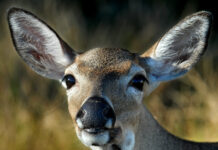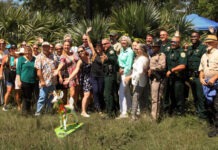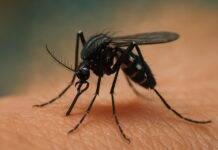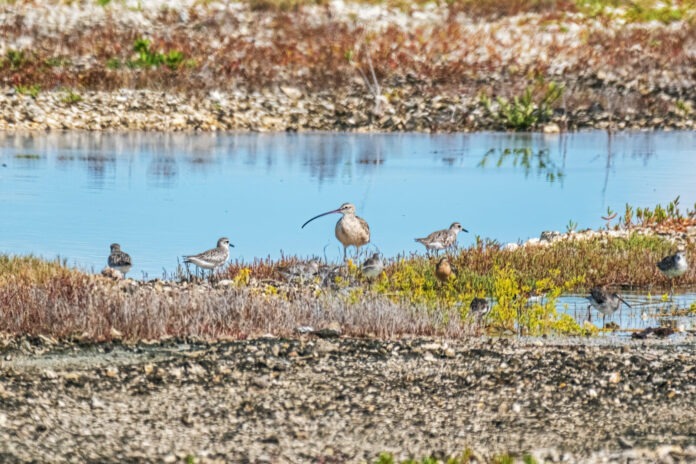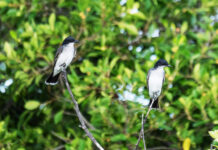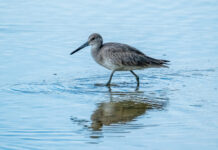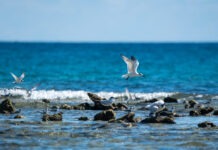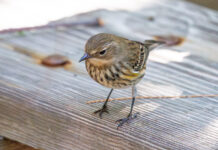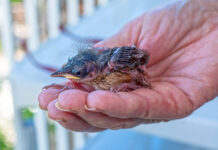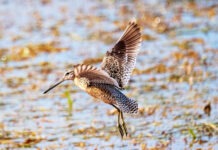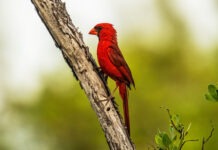Nine o’clock isn’t all that early, but there was still enough humidity in the air to fog the lenses of my binoculars and camera when I got out of the car. I’d already seen four species of birds – red-bellied woodpecker, barn swallow, northern mockingbird and white ibis – before I shut off the engine, but it was going to be five or 10 minutes until I could take any photos. Which always makes me worry I’m going to see the best bird ever and not be able to take any pictures, or even get a good look at it.
I can’t tell you the last time I went up to the beach on Boca Chica Road to look for birds. Which is odd because I used to go up there every week or so. Personal mission drift, I guess.
There was a report of a long-billed curlew up there a week or so before, but nobody had seen it since. So there wasn’t a lot of reason to make it the focus of my efforts, though I was still thinking about it. A curlew is always something to see.
Years ago, I’d gone on a nature tour with my sister Karen and my brother-in-law Lee up in the 10,000 islands off Everglades City. They’d hired a local guide, an older guy, and we all climbed onto his skiff.
If you’ve never been to Everglades City it’s an interesting place, with a vibe that doesn’t really jibe with the rest of modern Florida. Possibly because it’s a very small town in an isolated place. Possibly because it was so entwined in the pot smuggling trade that by 1984 at least 80% of the men in town had been arrested for smuggling, vastly outpacing even Key West on a per capita basis.
The guide didn’t seem much interested in small talk. Or in nature. But he did know his way around the twisty mangrove rivers. Occasionally he would point out a bird, invariably calling it a curlew, despite none of the birds being curlews.
Early on I’d try and say something polite, like, “Are you sure that’s not a white ibis?” and he’d just give me a look. I resisted asking, “Is the curlew behind the green heron?” which is a popular construct for birder snark.
In the end we returned to the dock in silence.
Historically, there were four species of curlew in North America, all of which are most easily identified by their long-ish bills – the Eskimo curlew, the bristle-thighed curlew, the whimbrel, and the long-billed curlew.
The Eskimo curlew was one of the species that once numbered in the millions, with flocks that would darken the sky, like passenger pigeons. And like passenger pigeons they were pretty much hunted to extinction. There hasn’t been a confirmed sighting of the species since the 1980s.
The bristle-thighed curlew breeds in two remote areas of the Alaskan tundra, and migrates, at minimum, 2,500 miles non-stop over the Pacific to overwinter in the islands of Oceania. It would be cool to go to Alaska and see one, but it would be magnitudes of unlikely for one to show up here.
Whimbrels actually breed in the cold parts of both the Eastern and Western Hemispheres, and winter along the warmer coasts of all the continents, except Antarctica. (It’s always “except Antarctica.”) I tend to think of them as the most common of the extant curlew species, largely because I see one on the coaling docks almost every time I go to the Dry Tortugas.
Long-billed Curlews once bred across most of the U.S., possibly as far east as South Carolina and Florida. But hunting and habitat change knocked their population down heavily, and by the 1800s they were wiped out in the eastern half of the country. The population in the western half was for many years considered highly imperiled, but due to environmental protections, those numbers have improved.
They still get seen here and there, usually birds that are one day wonders, and usually in winter.
I’d seen long-billed curlews a time or two in California, but never in the east.
It is such an odd looking bird, with the bill making up to a third of their body length, that the adjective long feels like it doesn’t do the length of the bill justice. The species makes ibises look like amateurs.
Long-billed curlews are sexually dimorphic, but in an inverse-of-the-norm sense, with the females being up to 15% bulkier, and also having bills on average a third again as long as the male’s. (They are also somewhat reversed in the parental care dynamics, with the females usually deserting their chicks two to three weeks after hatching, leaving their care to the males.)
There has been a pretty solid influx of sargasso weed this summer, which annoys humans, but is great for shorebirds. Walking along the beach, hundreds of shorebirds were all gorging themselves on the insects and crustaceans contained in the weed. It was a spree of untidy activity. Short-billed dowitchers, least sandpipers, black-bellied plovers, Wilson’s plovers, ruddy turnstones, spotted sandpipers, and a dozen young red-winged blackbirds thrown in for good measure.
Sometimes the birds ignored me, sometimes my shadow inspired a segment of them to collectively leap into the air and fly half a furlong down the shore.
I was so happy seeing so many birds that not seeing the curlew on Boca Chica Road didn’t even enter into it. You can’t see everything. But some mornings it feels like you saw everything.
I turned around when I made it to the barrier at the end of the road. I’d sweated through my shirt. A message warning with an exclamation point came on my camera screen, reading “Camera is approaching standard temperature limit.”
It seemed a good time head back to the car.
I wasn’t moving all that quickly, but when I got to the end of the runway I slowed up further to scan the ponds on the Navy side of the fence. I’d checked it out on the way down and there were birds there, but pretty much the same species I was seeing much closer on the beach.
I was going through the motions when my binoculars snagged on something, a bird that was bigger and taller than the surrounding shorebirds. It had a tiny head and a long bill. Actually, I should probably say she had a tiny head, the bill was so long.
Almost immediately after I caught sight of her, she tucked her bill under her wing, as if spitefully denying me a good look at her defining characteristic. So I walked on, stopping every 20 yards to see if she’d changed her stance. Nothing, nothing, nothing, and then she lifted her head, started walking, and gave me 30 seconds of a really nice profile.
She was 200 yards away, and I was shooting through a fence, but I got a passable photo, one in which there was no denying what she was.


